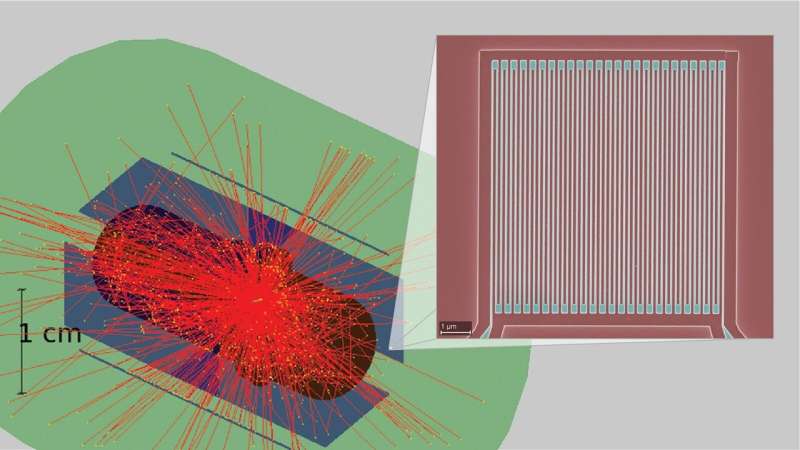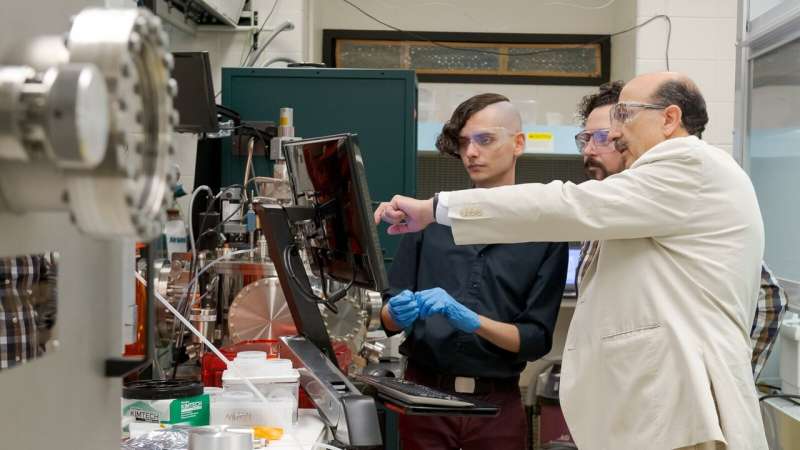When superconductivity material science meets nuclear physics

Imagine a wire with a thickness roughly one-hundred thousand times smaller than a human hair and only visible with the world's most powerful microscopes. They can come in many varieties, including semiconductors, insulators and superconductors.
Scientists at the U.S. Department of Energy's (DOE's) Argonne National Laboratory report fabricating and testing a superconducting nanowire device applicable to high-speed photon counting for nuclear physics experiments that were previously thought impossible. This device operates at temperatures near to absolute zero in magnetic fields forty times stronger than previous such devices and is able to detect low-energy photons as well as other fundamental particles.
"This changes the game for the type of particle detector one can design and build," said Zein-Eddine Meziani, senior physicist in the Physics division. "Think of this as the first unit of something for which we can ultimately connect many of them together in different configurations for use in various nuclear physics experiments."
The key property of this technology is superconductivity. At the beginning of the twentieth century, Dutch physicist Heike Kamerlingh Onnes discovered the remarkable property of superconductivity in metals. These superconducting materials lose all resistance to the movement of electricity at a temperature of near absolute zero and have found many different applications over the past century.
"We chose as our material one of the first superconducting alloys ever discovered, niobium nitride," said lead author Tomas Polakovic, graduate student in the Physics division. "Having been first identified as a superconductor in 1941, this alloy is extremely well understood, is easy to work with, and functions in an environment with high magnetic field and intense radiation bombardment."
About 15 years ago, scientists found they could fabricate niobium nitride in nanowire form. Over the years, this material has undergone many improvements by various research groups around the world for possible applications in quantum communication and sensing.
The Argonne team combined a nitrogen ion plasma with sputtering of niobium to form thin films of niobium nitride on a silicon substrate. The resulting film is only 10 nanometers thick, roughly 100,000 smaller than a human hair. They then shaped the nanowire into an integrated circuit-like pattern.
When a nanowire detector carrying a large current absorbs a photon, superconductivity is disrupted, creating a local hot spot. This produces a brief signal, which is electrically counted and measured, then the detector rapidly recovers its lost superconductivity and continues counting. Testing demonstrated that the device can detect individual low-energy photons in the demanding conditions of nuclear physics experiments.
While other detectors must operate at around room temperature outside the enclosed space where particles are streaming, scientists will be able to position the Argonne nanowire detector within that space because it can withstand the harsh conditions therein: temperatures near absolute zero, a strong magnetic field, and high particle rate.

"Rather than replacing existing detector technology, our technology opens many new possibilities for nuclear physics experiments," co-author and Argonne physicist Whitney Armstrong said.
Looking to the future, Polakovic added, "Although we have not tested this hypothesis yet, our device should be able to detect and analyze the signals from not only low-energy photons, but also individual electrons, protons and nuclei like helium-4, which consists of two protons and two neutrons."
One possible nuclear physics experiment would involve using the Argonne device in experiments with helium-4 to test the reigning theory of the atomic nucleus, quantum chromodynamics.
Joseph Heremans, a physicist in Argonne's Materials Science division and Center for Molecular Engineering, is already working to incorporate this technology into his quantum research: "The development of these fast, robust superconducting nanowire devices is an important step toward the implementation of broadband single-photon detection for quantum communication applications."
"Inventors seldom initially understand all possible uses of their inventions," Meziani added. "I'm sure there will be all kinds of ideas for cutting-edge science experiments using our superconducting nanowire device in the future."
A paper based on this study, "Superconducting nanowires as high-rate photon detectors in strong magnetic fields," appeared in Nuclear Instruments and Methods in Physics Research. In addition to Polakovic, Armstrong, and Meziani, authors are V. Yefremenko, J.E. Pearson, K. Hafidi, G. Karapetrov and V. Novosad.
More information: T. Polakovic et al, Superconducting nanowires as high-rate photon detectors in strong magnetic fields, Nuclear Instruments and Methods in Physics Research Section A: Accelerators, Spectrometers, Detectors and Associated Equipment (2020). DOI: 10.1016/j.nima.2020.163543
Provided by Argonne National Laboratory





















